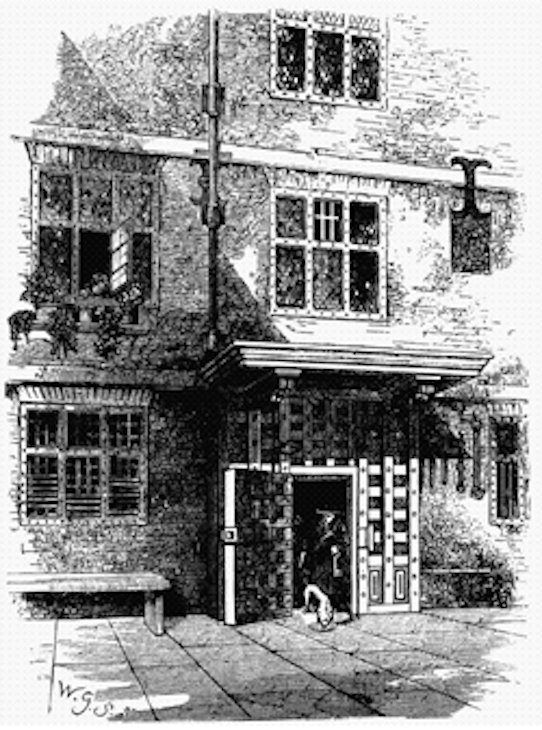
Compters – sometimes called counters – were small prisons for minor transgressors such as debtors, religious dissidents, drunks, prostitutes, homosexuals and asylum-seeking slaves. But their inmates were overwhelmingly debtors. They existed from medieval times and were all closed by the mid-19th century, their inmates being dispersed to other institutions.
London had two compters north of the river (Wood Street and Poultry) and one south (Borough). Wood Street was preceded by Bread Street until 1555 and succeeded in 1791 by Giltspur Street, but essentially the heyday of compters involved the three mentioned.
Compters were run by a sheriff and his staff, all of whom were essentially a law unto themselves, parliamentary inspectors having no jurisdiction within the walls. They charged inmates for everything essential to survival and comfort: food, drink, clothes, bedding, warmth, medicine – the lot. Many prisoners – by definition already having money problems – often found themselves in a downward spiral of increasing poverty and squalor. In theory they could take in work from outside – tailoring, shoe repairing and the like – but this seems rarely to have happened in practice. At their height in the 17th and 18th centuries, compters would often lose half a dozen inmates per week to disease, but there was on shortage of re-supply.
These institutions were notorious even in their own time with constant complaints from reformers and former prisoners via Parliament, newspapers and pamphleteering, to little avail. An Act of Parliament was passed in 1712 designed to alleviate the plight of demonstrably irredeemable debtors – it had little effect. It was not until the groundswell of Victorian reform was sufficiently powerful that compters were finally shut down for good in the 1850s.
Wood Street Compter

Wood Street Compter, in Cheapside, opened in 1555 as a replacement for Bread Street Compter from where all the inmates were transferred. Depending on how flush you were, when entering the compter you could choose to stay in the Master’s Side, the Knight’s Ward or the Hole, these names being self-explanatory as to what level of comfort you could expect. Every officer and every service had to be paid for by the prisoner, what was known as “garnish”. Incarceration in the compter could be a very expensive experience indeed. A pamphlet of 1617 complained that:
…when a gentleman is brought in by the watch for some misdemeanour committed, that he must pay at least an angell before he be discharged; he must pay twelvepence for turning the key at the master-side dore two shillings to the chamberleine, twelvepence for his garnish for wine, tenpence for his dinner, whether he stay or no, and when he comes to be discharged at the booke, it will cost at least three shillings and sixpence more, besides sixpence for the booke-keeper’s paines, and sixpence for the porter...
Wood Street Compter was burned down in the Great Fire and rebuilt within a few years. It was eventually closed in 1791 and its inmates transferred to the new Giltspur Street Compter.
Poultry Compter

Also based in Cheapside, Poultry was named because of its proximity to the poultry market. Compters did not officially have specialities, but Poultry was known for its Jewish and black inmates. The former was probably simply due to its proximity to Jewry with its concentration of Jewish residents. It is said that the compter escaped attack during the Gordon Riots of 1780 because Lord Gordon had strong Jewish sympathies. The black prisoners were almost all ex-slaves, whose legal status was ambiguous. Their owners claimed that they were still slaves, while reformers and the men themselves, reasonably argued that there was no slavery in Britain and therefore once on British soil they had become free men. It was shortly after an ex-slave James Somerset won his freedom in just such a case in 1772, that the poet William Cowper wrote:
Slaves cannot breathe in England; if their lungs
Imbibe our air, that moment they are free
Poultry Compter was pulled down in 1817.
Borough Compter
Borough was the only compter south of the river. Originally in Borough High Street, it moved to Tooley Street in 1717. It was overwhelmingly a debtors' prison, but held a small number of proper felons over the years. It was closed in 1855, almost simultaneously with Giltspur Street, bringing an end to the era of compters.
Giltspur Street Compter
The newest of the compters, Giltspur Street opened in 1791, replacing Wood Street and absorbing some of Poultry’s inmates when that institution closed in 1817. It was based in Smithfield, opposite Newgate Prison. There was a plan to convert the compter into a full-fledged prison in 1819, but nothing came of it in the end. Giltspur Street was eventually closed in 1853 and demolished two years later.
Sources: Wikipedia, as per.The best source I found, drawn on heavily here, is Old and New London, Vol.1 (1878) by Walter Thornbury, re-published online by British History Online (sponsored by the Centre for Metropolitan History). The bits about Wood Street Compter and Poultry Compter, as linked here.
This article originally appeared on London Historians. You can become a London Historians member here.



